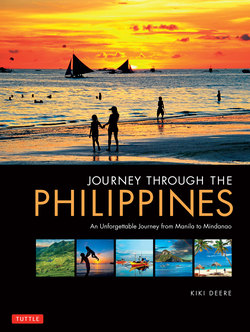Читать книгу Journey Through the Philippines - Kiki Deere - Страница 11
На сайте Литреса книга снята с продажи.
ОглавлениеFEASTS AND FIESTAS
LAVISH CELEBRATIONS FILLED WITH SONG, DANCE AND FOOD
As a result of three centuries of Spanish colonial rule and nearly five decades of American colonization, Filipino culture is heavily influenced by Hispanic and American traditions. Hundreds of exuberant Catholic celebrations feature colorful spectacles that embrace traditional songs, dances and lavish feasts.
Fiestas lie at the heart of Philippine culture. There are hundreds of ebullient festivals and raucous celebrations year-round, mostly rooted in Christianity. Often held to commemorate patron saints, they were largely introduced by the Spanish and became a vital means of spreading Christianity to all corners of the country. Today they can be both religious and cultural, with parades, street performers, re-enactments, plays, pageants and contests. Holy Week and Christmas are celebrated with unbridled enthusiasm, with extended families coming together from across the country.
An important day for families is Todos Los Santos, or All Saints’ Day, which is celebrated to honor the dead. The entire country comes to a standstill, with Filipinos traveling far and wide to spend the day with their relatives and pay tribute to the deceased. Family members prepare abundant feasts and travel to the cemeteries, gathering around graves and memorials.
Participants at the Senakulo watch a re-enactment of Christ carrying his cross to Golgotha.
Filipinos re-enact the crucifixion of Jesus Christ during Easter celebrations.
A man in Cainta, Rizal, plays the role of Jesus at the Senakulo, a play depicting events from the Old and New Testament.
Participants at the annual Aliwan Festival showcase their culture and traditions.
Ifugao man playing a bamboo nose flute locally known as “kaleleng”. The Ifugao tribe mainly resides in the Cordilleras in Luzon.
A band of young musicians plays at the Philippine Independence Day Parade in Kawit, Cavite.
A street dancer at the Dinagyang Festival, a religious and cultural event held in Iloilo both to honor the Santo Niño and to celebrate the arrival of Malay settlers.
Flowers are arranged and candles lit, and picnic hampers and alcoholic drinks are opened to celebrate and pay respect to those who have passed.
Feast days are sometimes held for two or three consecutive days, with lechón gracing the tables, and street parades featuring dancers clad in colorful costumes. Most fiestas are held between January and May, although all barangays (districts) in the Philippines put on at least a couple of celebrations a year to commemorate their patron saint. Held in honor of the Virgin Mary, the Flores de Mayo Festival in May is one of the country’s largest, along with Kalibo’s Ati-Atihan Festival that features street dancing and wild costumes.
Filipinos’ friendly disposition is captured in the numerous cultural dances that originate from all corners of the archipelago. Ethnic tribal dances in the Cordilleras feature wooden instruments such as bamboo flutes, while dances in the highlands of Mindanao and the Sulu archipelago embrace Muslim Filipino culture and echo the islands’ Arabian and Indo-Malayan influences.
While the country had a rich musical tradition long before the arrival of the Spanish, Catholicism strongly impacted Philippine musical traditions. In the 19thcentury the piano and European string instruments were introduced. Bands of musicians were formed and began playing at town celebrations. Groups often gathered to form a rondalla, a band of stringed instruments played with a plectrum, such as the double bass and twelve-string guitar. During US rule there was a shift to American tunes and songs, and it was only in the 1970s that OPM (original Pilipino music) took off.
Participants at the Sinulog Festival reach out to a statuette of the Santo Niño, or Baby Jesus.
A marching band carrying percussion instruments sports colorful dress at the annual Ati-Atihan Festival on Boracay Island.
A man stands on a large float atop two model lions at the Aliwan Festival, which celebrates the country’s diverse cultures.
